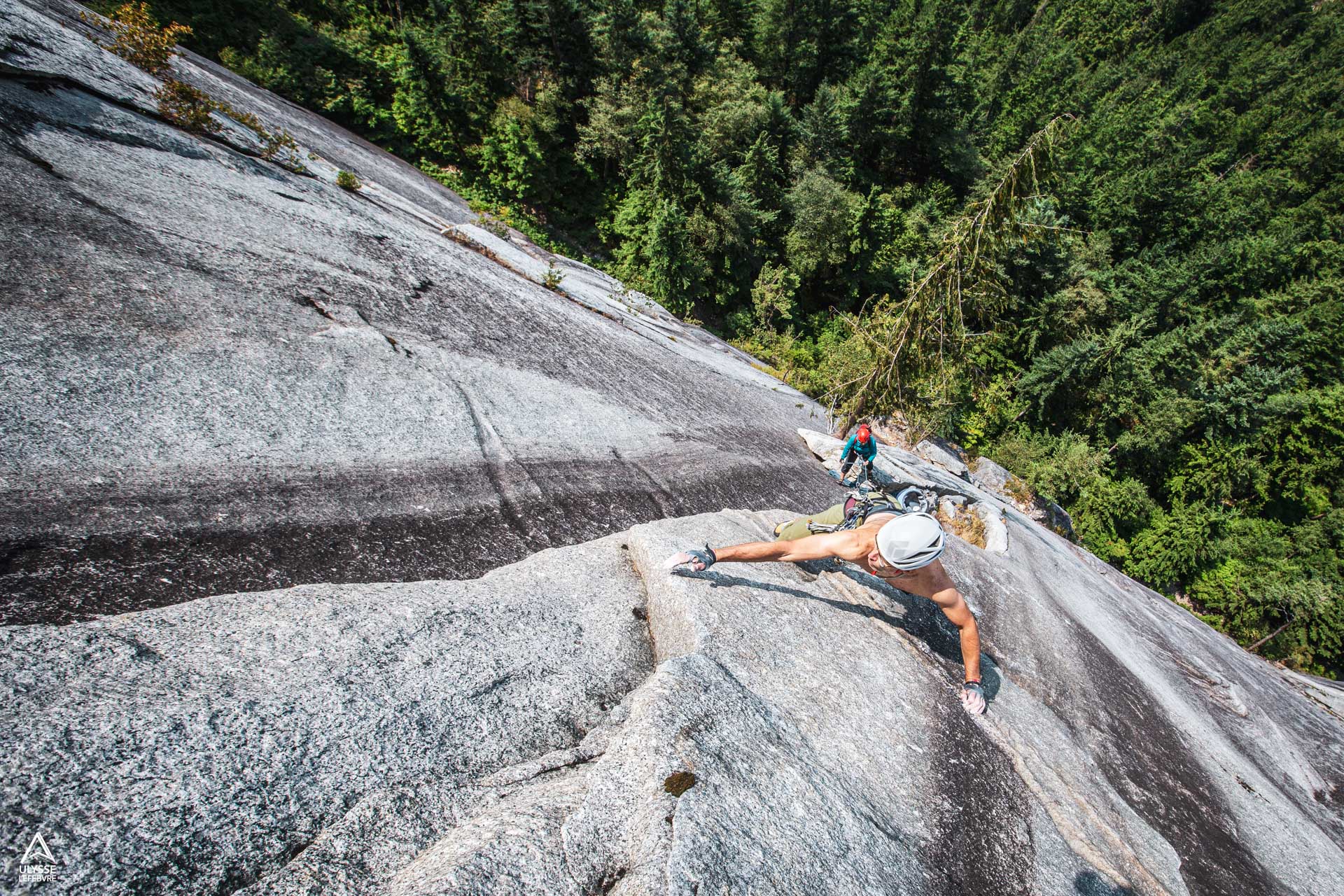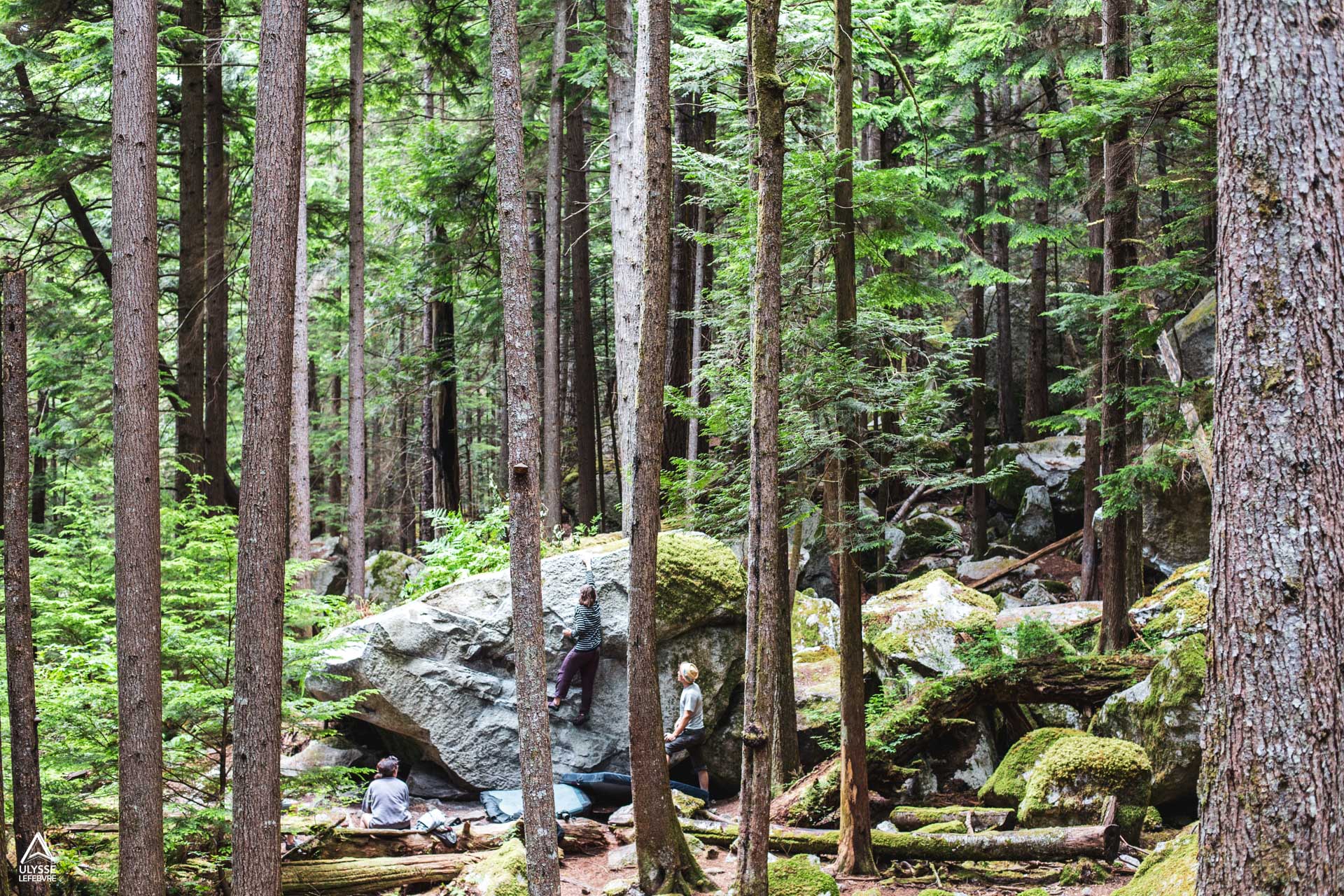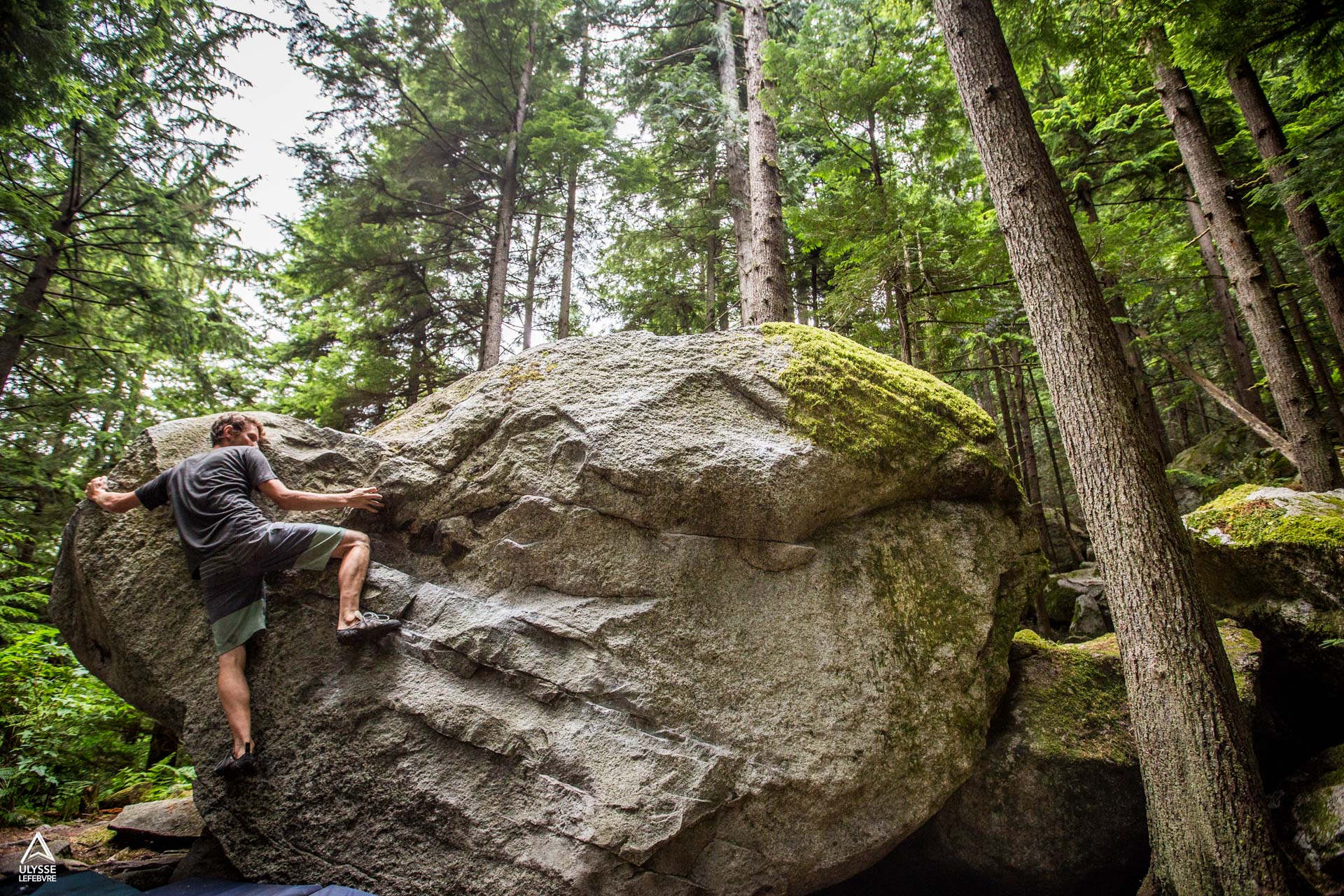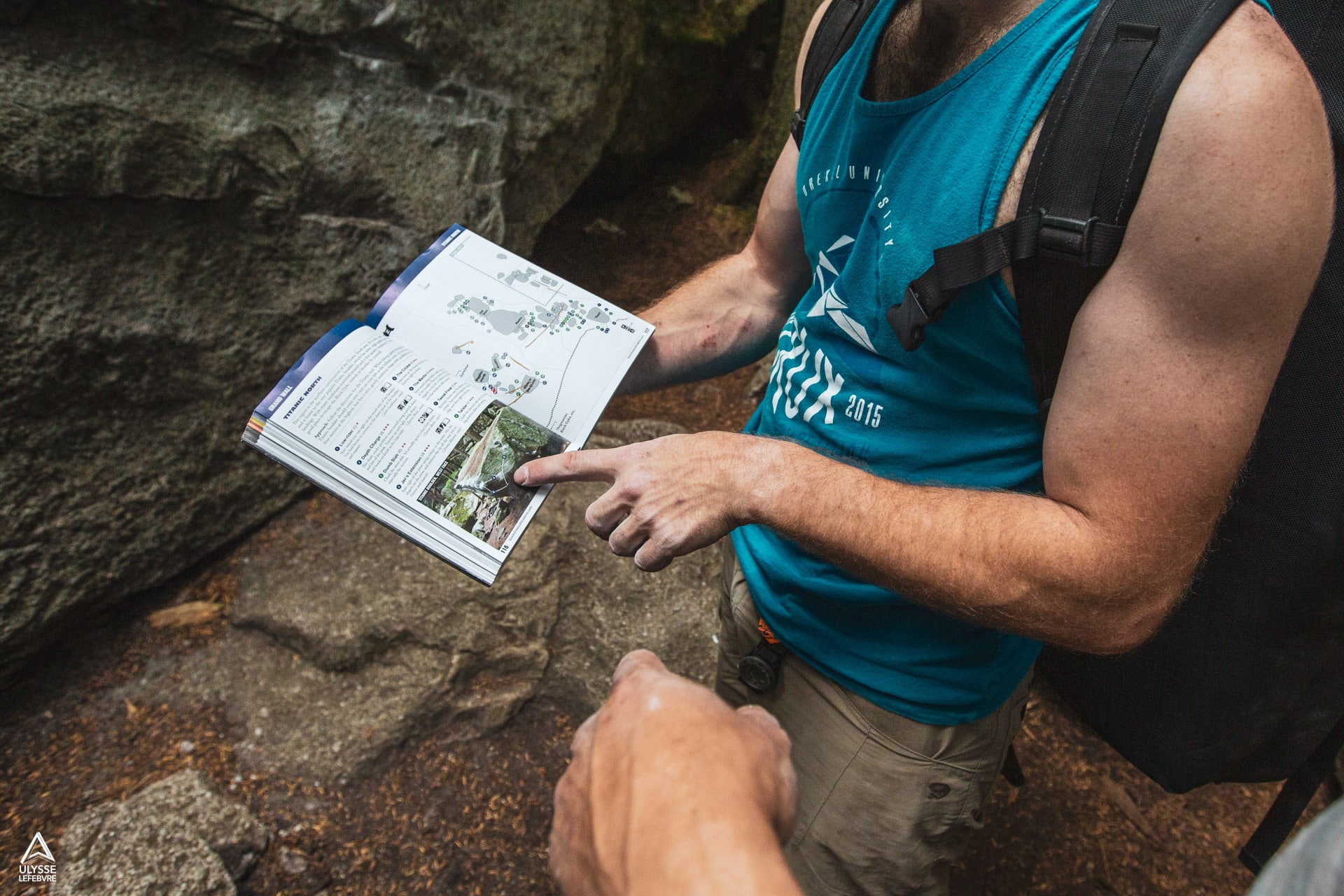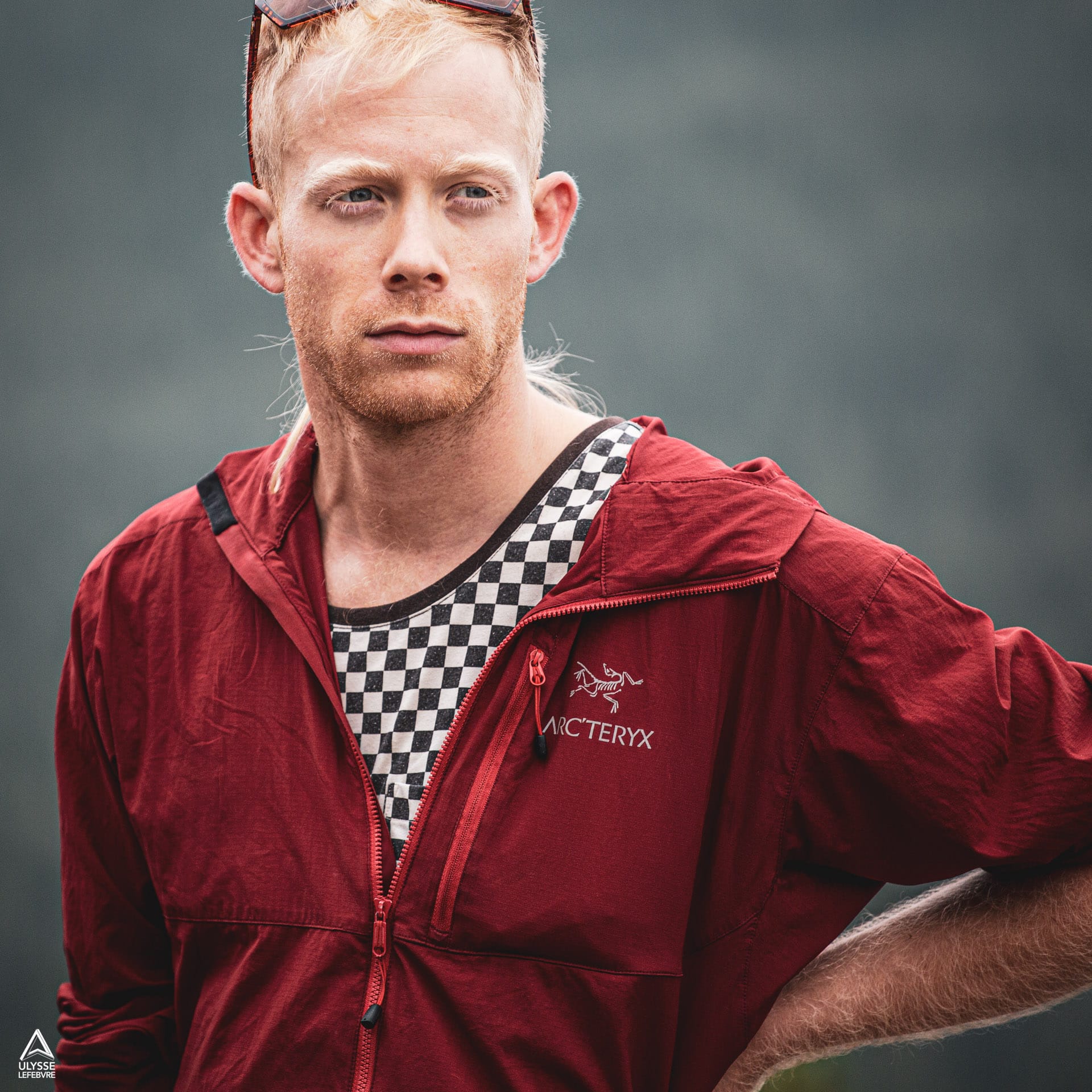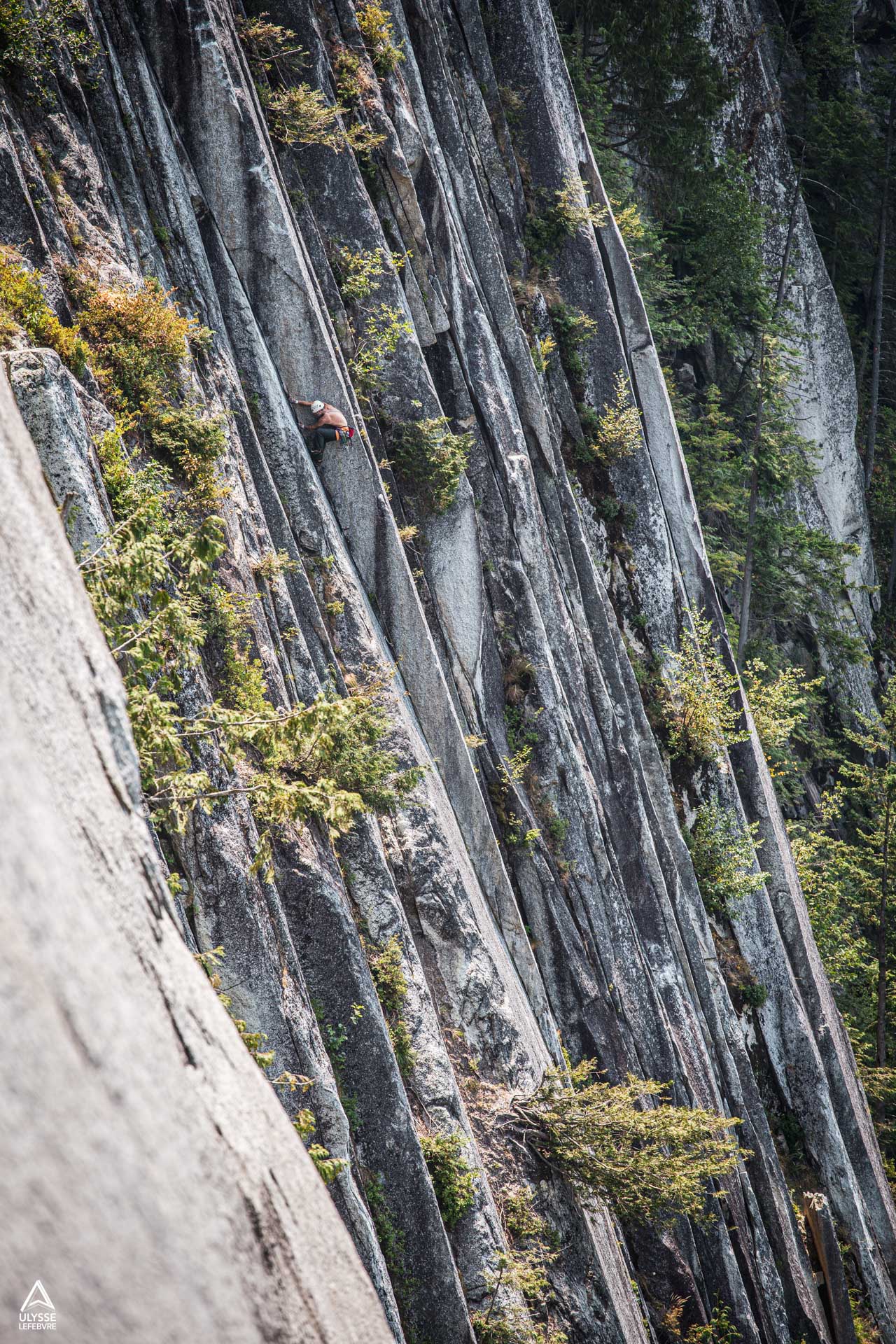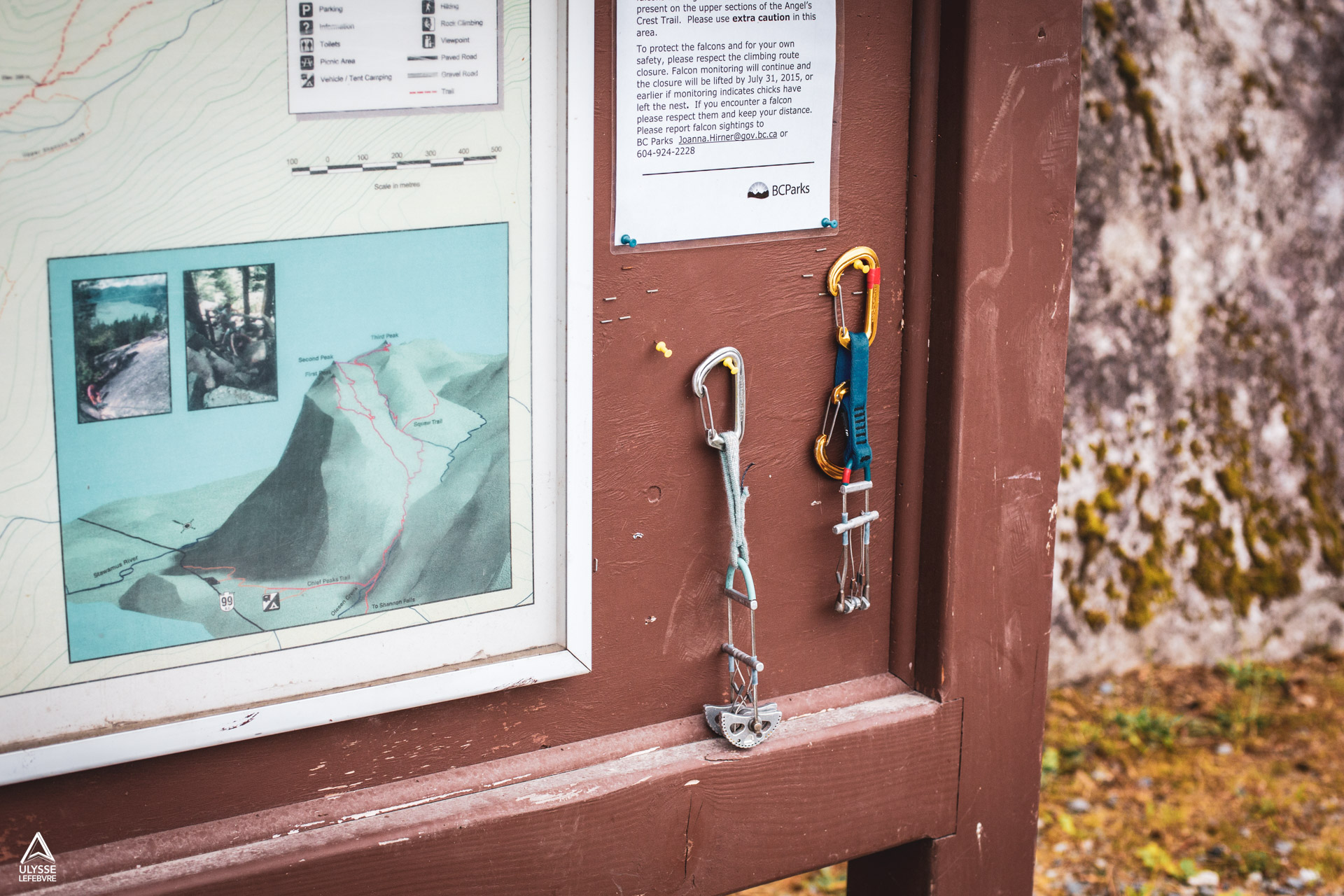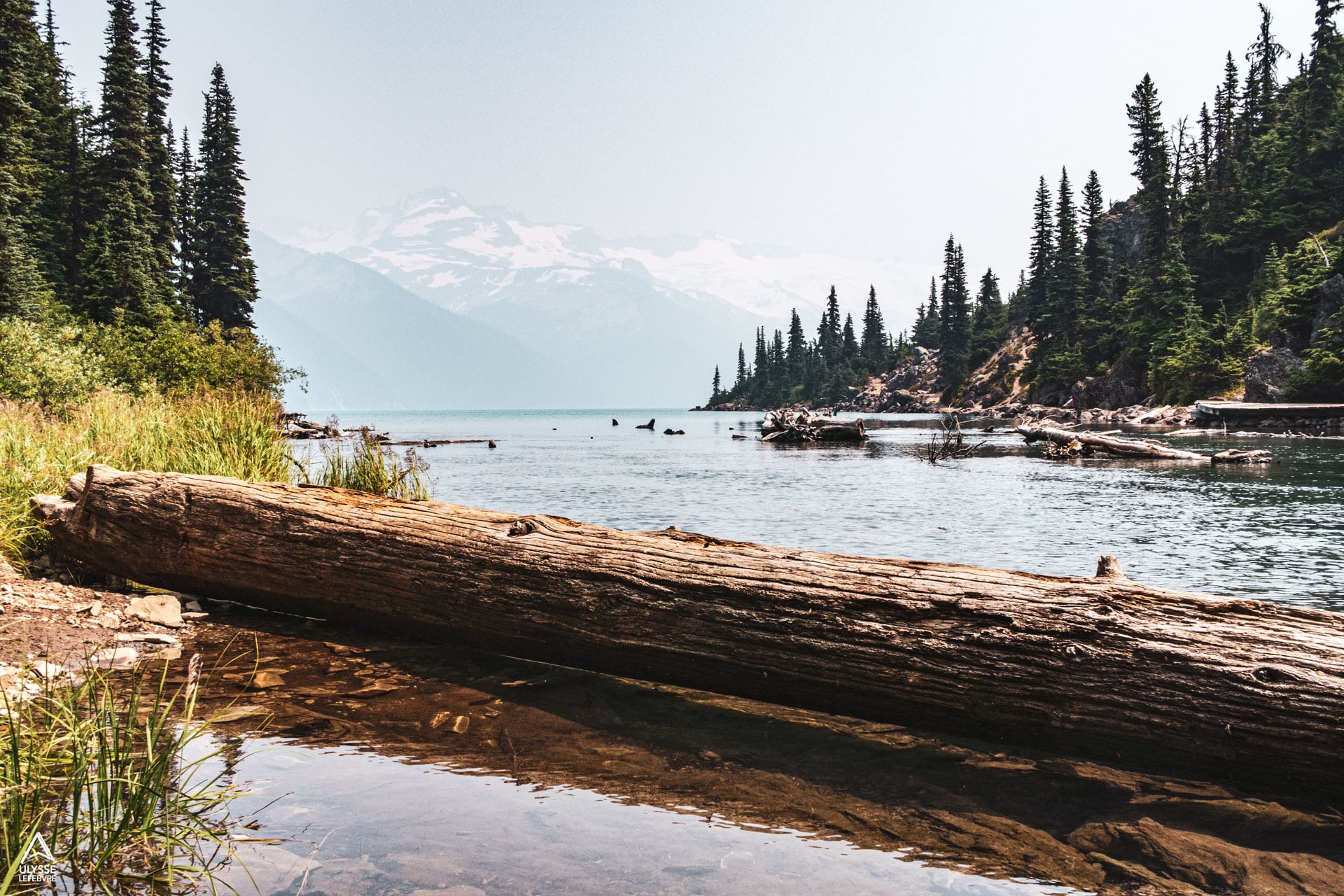Squamish is often referred to as the Canadian antechamber to Yosemite. And with good reason: like its American neighbor, the Chief’s imposing granite mass is dotted with fissures that form lines renowned in America for their purity. Here’s an overview of Squamish, its atmosphere and some of its lines, trhough the eyes of a french climber. In the time it takes to go round the clock.
It’s 5 am, Squamish wakes up
Well, not really. Nestled at the head of Howe Sound, Squamish is a port town on Canada’s Pacific coast. As a result, the air is never very cold, but rather humid. To be honest, it’s the wettest place in all of Canada, with up to 2400mm of rainfall a year… Weather you wouldn’t want to take your slippers off in, especially early in the morning. If July and August are the best months for climbing (in other words, the driest months), the rest of the time you have to juggle between showers and plan B, C or even D in case of rain. So why on earth come here to try your luck?
In this corner of the Canadian Rockies, in the province of British Columbia, Squamish has the reputation of a mountain town resolutely focused on outdoor sports. Mountain biking is king here, as are rafting and mountaineering. Remote, wild peaks attract the most patient of mountaineers, such as Mount Garibaldi (2,678m), Tantalus (2,608m), Wedge Mountian (2,892m) or, more modestly, Black Tusk for hikers (2,319m). Above all, less than an hour from Vancouver, the pure granite of Chief is a coveted target for most climbers on the American West Coast. A cracking Mecca.
7:03 am Coffee smells and car door noise
There’s a Camp 4 feel to the Stawamus Chief Provincial Campground, the climbers’ campsite. This is where the American way of climbing, with its maple syrup, finds its inspiration, just a few minutes from downtown, a handful of steps from the first routes and a few seconds from the world-famous Cacodemon boulders. The smell of coffee fills the fresh morning air as you emerge from the tents and converted vans. We also roll the first joints, our eyes still glued by a bad night on a bad mattress.
Felix, Lisa and Olivier are living their third morning in the shadow of the Chief. Tight as sardines in their crammed old car, they left Montreal a month ago and are crossing Canada from east to west. Squamish is one of their must-see stops. “More for the atmosphere than for the climbing,” admits Lisa, who somehow manages to keep up with her fellow climbers on the foamy boulders.
Public toilets, drinking water, sheltered kitchen area… What more could you ask for when you’re a climber on the road? Ah yes, a shower perhaps. But let’s not stoop to such lowly hygienic considerations. The Chief is above us. The soap will wait. Not the chalk.
9:17 am Kruk in the air
“Weird”. That’s how some of his acquaintances and friends describe the local of the stage. With his half-skater, half-squater look, Jason Kruk is a discreet, taciturn, tormented character. A local enfant terrible, he can be seen walking down the street with his gear under his arm and his dog never far away. Early in the morning, Kruk leaves his Squamish home to start his day outside. The animal is an early riser. Radical. After caffeine, he needs the adrenalin of a BASE jump. “This is my second coffee,” he says. The Chief’s imposing granite mass is his exit, his springboard.
Kruk is a local legend
When he’s not running up the hiking trail, he’s soloing a route of his choice. Kruk loves cracks. The Chief’s lines of weakness hold no secrets for him. He’s also one of the guarantors of trad climbing in Squamish. Don’t talk to him about bolts. He blasts them, disperses them, ventilates them. Friends are his dope.
In 2012, the brazen climber exported his vision of clean climbing to Patagonia. With Hayden Kennedy, he unbuttoned the historic Maestri route (known as the Compressor). The result: 400 spits, or around 80kg of metal, which got them into trouble with the mountain community of El Chalten. And the reopening of an old debate… 3,2,1, BASE. Kruk takes off. Let’s climb.
10:15 am A vague promontory
For those accustomed to water drops, reglettes and other colos, it’s best to get off to a slow start. Before tackling 400m of cracks, it’s a good idea to warm up modestly on a few short sport routes, even if it means clipping a few bolts before getting out the jammers.
If you’re French, no one will hold it against you. The small site of the Smoky Bluffs, just above the town center, is ideal for rubbing shoulders with the local granite and brushing up on the basics. Cracks, of course, to check the state of your wrists and ankles. There are also flat areas and granite bulges whose existence lies in a few millimetres of elevation in relation to the rest of the wall.
Will Gadd, unperturbed by the mossy nature of the rock. ©UL
There are no fucking holds !
Will Gadd
“These 5.12b slabs are not fun man. There are no fucking holds!” grumbled Will Gadd (about The Technician route), another visiting Canadian and rare international climbing star. So yes, a fortiori, the French climber’s ego takes a hit. Yes, a 5.10a is supposed to be a 5c. Yes, you’re climbing 7a indoors, but you come up against a 5.8 that’s “surely undercut!” And yes, you’re going to have to get used to crack techniques, hand jams and ankle jams, rather than desperately searching for a foothold, exhausting yourself in Dülfer, or believing in the superiority of the scraper over the fist jam. Welcome to America.
2:00 pm Peasant’s route
Here we are. At the foot of the wall, sweaty hands. On the attack for a real big route at Chief, with real difficulties for the average climber and real protection to avoid measuring the degree of friction of the rock on your skin. Peasant’s route (5.10c, 120m): a classic that offers a first foray into this ocean of granite. A fine crack, a technical dihedral, a slab and a pine tree to give your joints a rest before setting off again. The heart of the matter, with Squamish harbour in the background and floating logs waiting to be loaded. And one crack after another…
Starting Peasant’s route. ©UL
Raphael Slawinsky, far from K6 West in Pakistan, an ascent for which he won a Piolet d’Or in 2013 with Ian Welsted. ©UL
The hand protector that we thought was supefluent turns out to be quite useful for keeping the skin on the backs of our hands… safe. A little ill-at-ease with our feet, we’re almost tempted to dream of ankle-protecting booties. And so much for style. More than anywhere else, you need to avoid straining your arms and concentrate on balancing your body around the pivot point where your hands get stuck. There’s no point in pulling, you’ve got to clench your fist. To the point.
4:41 pm Validation of prior learning
Just off Peasant’s route, a line sees the crowds pass by. You’d almost have to buy a ticket or camp at the foot of it to even hope to get a crack at it. You’d end up exasperated even before climbing Exasperator (5.10c). But if you want to prolong the experience, these two short pitches are ideal for building up power. It’s a line as pure as a windshield crack (automotive poetry, an American dream). It’s enough to give wings to the novice, who sees this challenge all the more confidently because the lengths are short and the protections obvious to place. Yet there’s no room for the slightest error of balance.
And when the crack widens in an arc, we have to get our feet out on the slab to keep only four phalanges in the stone’s mouth. Sweating. An arm around the chain concreting the belay. That’s it. For the style, you’ll have to go back a few times. However, it’s this style of climbing that you’ll need to master if you want to take on larger-scale routes, such as The Grand Wall (5.11a) for the crack, or Dancing in the light (5.11b) for the steely mentality you’ll need to maintain in the slabs of a base that offers little protection.
5:35 pm Gluten-free tacos
Early dinner in British Columbia. Still, we’ll have to get the route out on time. It’s amazing how the prospect of a good meal often speeds up rope maneuvers on the way down, even for the most awkward. Before even starting a third half in a downtown bar, it would be unwise to skip a stop at Mag’s 99, just off Highway 99.
This cantina mexicana is nothing short of a den for the penniless hungry. A landmark in the Squamish climbing scene. It’s here that we discuss the day’s notched routes while munching on a taco dripping with “brown” sauce, debate the ratings while stuffing our faces with burrito, and down the first beers of the evening, light and cheap, for the general hydration of athletic bodies.
Fans of more delicate dishes will of course be excused if they don’t deign to visit Mag’s 99. But they’re sure to miss out on a good plan or two for their climbing plans the next day. By the way, as the portions are more than generous, ask for a gluten-free XL taco: the cook doesn’t have gluten-free patties big enough, so he has to serve two tacos on the same plate.Convenient for taking half of them to the foot of the Chief the next day, and greasing up those sweaty hands a little more so they won’t shake so much.Because tomorrow is another day, another clock with cracks in it.
Squamish and beyond
Even if the Chief is the focus of attention, even if it means intimidating novices, Squamish offers many opportunities and means to embark on adventures in complete serenity.
Arcteryx Climbing Academy: the Canadian equivalent of Chamonix’s Alpine Academy is a good place to start.The local (Vancouver-based) brand organizes this event with its athletes.There’s plenty of opportunity for everyone to climb, learn about cracking and roping techniques on the glacier, and watch films as part of the evening’s entertainment. Information on forthcoming editions >
Hiking & mountaineering: there’s no shortage of trails around Squamish. The walks here are long, and it’s not surprising that you’ll cover 20km in a long day to reach a summit. The same goes for the surrounding peaks, which are often remote and often require at least one night in a refuge. The Canadian wilderness at its best. Info and guidance: altusmountainguides.com, westcoastmountainguides.com
Bugaboos? Why not combine the cracks of Squamish with those of the Bugaboos, a range world-renowned for its massive lines. A sort of “alpine” application of the lessons learned on the Chief… Count on 900km to Radium, which is not so much on a Canadian scale…
Incessant rain? the Grand Wall climbing Gym (1 logger’s lane) and Ground up (climbgroundup.com) are there to welcome struggling climbers to Squamish.
Access from France /Europe
Flight Paris or Geneva-Vancouver. Often a stopover in Montreal.From Vancouver, less than an hour’s drive north on Highway 99, along the coast.
Season / weather
July/August. The rest of the year is more uncertain in terms of temperatures and especially showers. Weather forecast on weather.gc.ca
Climbing guidebooks
Squamish Select, Marc Boudron, Quickdraw publications.
The climbers guide to Squamish, Kevin McLane, Elaho Press
The Grand Wall route is presented in Parois de légende, by Stéphanie Bodet and Arnaud Petit, Glénat.
www.squamishclimbing.com
Equipment
Classic climbing equipment. Full rack of friends and doubles up to size 2 (Camalot size). 60m rope is often sufficient, but a second abseiling rope is needed on some routes. Several equipment stores in Squamish.


